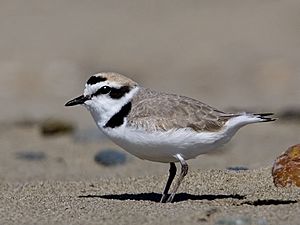Charadriidae facts for kids
Quick facts for kids Charadriidae |
|
|---|---|
 |
|
| Snowy plover (Charadrius nivosus) |
|
| Scientific classification |
|
| Kingdom: | Animalia |
| Phylum: | Chordata |
| Class: | Aves |
| Order: | Charadriiformes |
| Family: | Charadriidae Leach, 1820 |
| Genera | |
|
|
The Charadriidae are a family of birds that includes plovers, dotterels, and lapwings. These birds are found all over the world. There are 69 different species in this family, grouped into 10 main types, called genera.
Contents
What are Charadriidae Birds?
The Charadriidae family was first named by an English zoologist, William Elford Leach, in 1820. He wrote about them in a guide to the British Museum. Most birds in this family are known as plovers, lapwings, or dotterels.
Naming the Birds
For a long time, the names plovers, lapwings, and dotterels were used a bit loosely. Generally, bigger birds were called lapwings, while smaller ones were called plovers or dotterels.
Today, scientists have made the names more consistent. For example, a large Australian bird once called the 'spur-winged plover' is now known as the masked lapwing. Another bird, the 'sociable plover', is now the sociable lapwing. This helps everyone use the same names for these birds.
How to Identify Charadriidae Birds
These birds are usually small to medium-sized. They have compact bodies, short, thick necks, and wings that are often pointed. However, some lapwings have more rounded wings.
Physical Features
Their bills are usually straight and short, except for the wrybill, which has a unique curved bill. Their toes are short, and some species might have a very small or missing back toe. Most Charadriidae birds also have short tails, but the killdeer is an exception with a longer tail.
Male and female birds in this family often look very similar. They don't have many differences in their appearance. Their size can vary a lot. The smallest is the collared plover, which weighs about 26 grams and is 14 centimeters (5.5 inches) long. The largest is the masked lapwing, weighing around 368 grams (0.8 pounds) and measuring 35 centimeters (14 inches) long.
Where Charadriidae Birds Live
You can find Charadriidae birds in open areas all around the world. They usually live near water, like coasts, rivers, or lakes.
Different Habitats
However, some species prefer different places. For example, the inland dotterel lives in the stony deserts of central and western Australia. The killdeer is often found in grasslands across North America, far from water.
How Charadriidae Birds Behave
These birds hunt for food by looking for it, not by feeling for it in the ground like some other birds with long bills, such as snipe.
What They Eat
Their diet includes small animals without backbones, like insects, worms, molluscs (like snails), and crustaceans (like crabs). What they eat depends on where they live. They usually find food by running a short distance and then pausing to look, rather than constantly probing the ground. They also eat some plant material.
Breeding and Raising Young
Most Charadriidae birds have one mate at a time. However, some, like Northern lapwings, might have more than one female mate. Others, like mountain plovers, lay many clutches of eggs quickly, and females might even compete for males. In Eurasian dotterels, the females compete for males, and the males do all the parental care.
When it's time to breed, these birds defend their nesting areas with impressive flying displays. They usually lay two to four eggs in a shallow scrape on the open ground. The parents take turns sitting on the eggs for 21 to 30 days to keep them warm.
Parents share incubation duties in different ways. Some pairs switch places on the nest in the morning and evening, following a 24-hour cycle. Other pairs might switch up to 20 times a day!
Charadriidae birds are very protective of their eggs and young. If a predator or intruder comes near, the parents will make an alarm call. They might also pretend to be hurt to distract the danger, or even attack the intruder. The baby chicks are born ready to move around and find their own food; their parents do not feed them.

